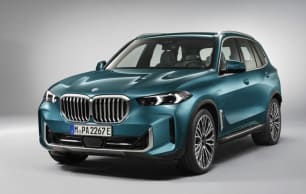With its 2165kg kerb weight and maximum allowable weight of 2885kg, our test vehicle can legally carry up to 720kg.
That should be ample for five adults (even better for kids) and their luggage, of which up to 100kg can be carried on the roof rails using a rack or roof box (both in BMW's accessory range).
Powered upper and lower tailgates provide good access to the luggage area, which is carpeted and equipped with a roll-out privacy screen, load securing hooks, a 12-volt accessory outlet and a first-aid kit stored behind a removable side panel.
The space-saver spare and tools are stored below the hinged load floor, so all luggage must be removed to access them.
Internal luggage space with the rear seat upright is 650 litres (0.65 cubic metres) which expands to 1870 litres (1.87 cubic metres) with the rear seat folded flat.
A useful load-carrying feature when the rear seat’s backrest is upright is a hinged centre section that folds forward and flat to carry long and narrow items.
These can stretch all the way from the tailgate to the dash if need be, which could be handy for carting anything from skis to home hardware purchases (firmly secured, of course).
It’s also rated to tow up to an impressive 3500kg of braked trailer, which matches the class benchmark for one-tonne utes.
However, given that tow-ball download (TBD) is usually around 10 per cent of trailer weight, the X5’s maximum TBD rating of only 140kg could be a challenge if 3500kg towing is required.
Front of cabin storage includes a big bottle-holder and bin in each front door, a glove box and on the right-hand side of the dash a pull-out driver’s bin, both of which are felt-lined.
The centre console, in addition to its wireless phone-charging pad, USB-A port and 12-volt outlet, has two small-bottle/cupholders up front and a large box at the rear, housing a USB-C port and topped by a padded dual 'brochure fold' lid that double as an elbow-rest for driver and front passenger.
Rear seat storage includes a large-bottle holder and bin in each door and pockets on each front seat backrest. The rear of the centre console has two storage nooks for small items in addition to its air-vents, two USB-C ports and a 12-volt outlet. There’s also a handy tablet-mount and USB-C port on each front seat backrest, which is great for long trips.
Folding down the rear seat’s centre armrest reveals two pop-out small-bottle/cupholders. And under its hinged lid is a hidden felt-lined compartment that’s ideal for storing slim screened devices away from prying eyes.






